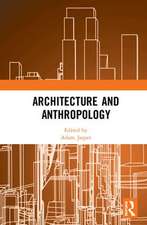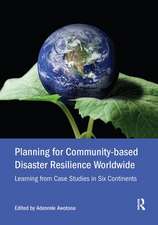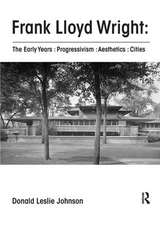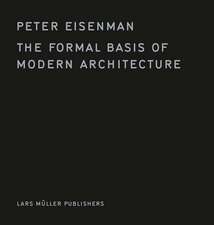Christian Norberg-Schulz’s Interpretation of Heidegger’s Philosophy: Care, Place and Architecture: Routledge Research in Architecture
Autor Hendrik Aureten Limba Engleză Paperback – 30 sep 2020
This book seeks to realign Norberg-Schulz's understanding of time as continuity and change to present a holistic approach grounded in Heidegger's phenomenological philosophy; architecture as art of care. Aimed at academics and scholars in architectural theory, history and philosophy,Christian Norberg-Schulz's Interpretation of Heidegger's Philosophysurveys the implications and significance of Norberg-Schulz's works on architectural criticism in the late 20th century.
| Toate formatele și edițiile | Preț | Express |
|---|---|---|
| Paperback (1) | 385.54 lei 6-8 săpt. | |
| Taylor & Francis – 30 sep 2020 | 385.54 lei 6-8 săpt. | |
| Hardback (1) | 767.20 lei 6-8 săpt. | |
| Taylor & Francis – 9 oct 2018 | 767.20 lei 6-8 săpt. |
Din seria Routledge Research in Architecture
- 9%
 Preț: 901.23 lei
Preț: 901.23 lei -
 Preț: 310.45 lei
Preț: 310.45 lei -
 Preț: 312.22 lei
Preț: 312.22 lei - 9%
 Preț: 1004.49 lei
Preț: 1004.49 lei -
 Preț: 312.44 lei
Preț: 312.44 lei -
 Preț: 351.26 lei
Preț: 351.26 lei -
 Preț: 309.89 lei
Preț: 309.89 lei -
 Preț: 311.66 lei
Preț: 311.66 lei -
 Preț: 310.41 lei
Preț: 310.41 lei - 9%
 Preț: 866.05 lei
Preț: 866.05 lei - 9%
 Preț: 936.17 lei
Preț: 936.17 lei -
 Preț: 449.41 lei
Preț: 449.41 lei - 31%
 Preț: 767.07 lei
Preț: 767.07 lei - 26%
 Preț: 766.24 lei
Preț: 766.24 lei - 12%
 Preț: 299.52 lei
Preț: 299.52 lei -
 Preț: 449.41 lei
Preț: 449.41 lei - 30%
 Preț: 768.30 lei
Preț: 768.30 lei -
 Preț: 449.41 lei
Preț: 449.41 lei -
 Preț: 489.26 lei
Preț: 489.26 lei - 18%
 Preț: 1003.43 lei
Preț: 1003.43 lei -
 Preț: 442.68 lei
Preț: 442.68 lei -
 Preț: 449.41 lei
Preț: 449.41 lei - 18%
 Preț: 1109.99 lei
Preț: 1109.99 lei - 26%
 Preț: 849.37 lei
Preț: 849.37 lei -
 Preț: 489.26 lei
Preț: 489.26 lei - 18%
 Preț: 998.71 lei
Preț: 998.71 lei - 18%
 Preț: 1054.71 lei
Preț: 1054.71 lei -
 Preț: 443.65 lei
Preț: 443.65 lei - 18%
 Preț: 1001.07 lei
Preț: 1001.07 lei - 31%
 Preț: 766.66 lei
Preț: 766.66 lei - 24%
 Preț: 324.16 lei
Preț: 324.16 lei - 26%
 Preț: 766.24 lei
Preț: 766.24 lei - 28%
 Preț: 708.63 lei
Preț: 708.63 lei - 26%
 Preț: 765.01 lei
Preț: 765.01 lei - 18%
 Preț: 1057.75 lei
Preț: 1057.75 lei - 26%
 Preț: 850.17 lei
Preț: 850.17 lei -
 Preț: 449.41 lei
Preț: 449.41 lei - 25%
 Preț: 716.13 lei
Preț: 716.13 lei - 26%
 Preț: 765.84 lei
Preț: 765.84 lei - 18%
 Preț: 1274.14 lei
Preț: 1274.14 lei - 18%
 Preț: 1165.20 lei
Preț: 1165.20 lei
Preț: 385.54 lei
Nou
73.78€ • 80.12$ • 61.98£
Carte tipărită la comandă
Livrare economică 22 aprilie-06 mai
Specificații
ISBN-10: 0367665247
Pagini: 250
Dimensiuni: 156 x 234 x 13 mm
Greutate: 0.36 kg
Ediția:1
Editura: Taylor & Francis
Colecția Routledge
Seria Routledge Research in Architecture
Locul publicării:Oxford, United Kingdom
Public țintă
PostgraduateCuprins
Notă biografică
Recenzii
David Seamon, Kansas State University, USA; Editor, Environmental and Architectural Phenomenology
"In many ways, Christian Norberg-Schulz’s place theory is more relevant today than when it was first written. That is why Hendrik Auret´s book is important and timely. The book provides a comprehensive consideration of Norberg-Schulz’s lifelong search for a deeper understanding of how architectural work is related to life. Auret´s research is attentive and thorough, and he presents his work regarding the "art of care" as a way towards designing and appreciating architecture as an art of life."
Gro Lauvland, Associate Professor, Norwegian University of Science and Technology, Norway
'In his book, Christian Norberg-Schulz’s Interpretation of Heidegger’s Philosophy, Hendrik Auret has provided significant insight into a crucial ‘blind spot’ in Norberg-Schulz’s interpretation of Heidegger’s fundamental ontological account of human being, or Dasein – one that might have made an important difference in his understanding of the implications of Heidegger’s thought for architecture. Far from resigning himself to accepting that Norberg-Schulz’s work is terminally vitiated by this omission, however, Auret has managed to breathe new life into the Norwegian’s work instead.'
Bert Olivier, Department of Philosophy, University of the Free State, South Africa
Descriere
Christian Norberg-Schulz's Interpretation of Heidegger's Philosophy investigates the theoretical contribution of the world-renowned Norwegian architectural theorist Christian Norberg-Schulz and considers his architectural interpretation of the writings of German philosopher Martin Heidegger. Though widely recognised as providing the most comprehensive reading of Heideggerian philosophy through the lens of architecture, this book argues that Norberg-Schulz neglected one of the key aspects of the philosopher's contributions: the temporal nature of being-in-the-world as care. The undeveloped architectural implications of the ontological concept of care in his work prevented the fruition of his ultimate aim, transforming the 'art of place' into an 'art of living'.
This book seeks to realign Norberg-Schulz's understanding of time as continuity and change to present a holistic approach grounded in Heidegger's phenomenological philosophy; architecture as art of care. Aimed at academics and scholars in architectural theory, history and philosophy, Christian Norberg-Schulz's Interpretation of Heidegger's Philosophy surveys the implications and significance of Norberg-Schulz's works on architectural criticism in the late 20th century.

















